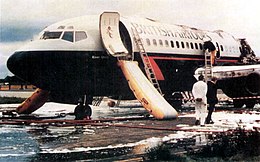British Airtours flight 28M
Coordinates: 53 ° 21 ′ 4 " N , 2 ° 16 ′ 54" W.
| British Airtours flight 28M | |
|---|---|
|
Sister machine River Way |
|
| Accident summary | |
| Accident type | Start aborted after a fire in the engine |
| place | Manchester Airport |
| date | August 22, 1985 |
| Fatalities | 55 |
| Survivors | 82 |
| Injured | 15th |
| Aircraft | |
| Aircraft type | Boeing 737-236 Advanced |
| operator | British Airtours |
| Mark | G-BGJL |
| Surname | River Orrin |
| Departure airport | Manchester Airport |
| Destination airport | Corfu airport |
| Passengers | 131 |
| crew | 6th |
| Lists of aviation accidents | |
British Airtours flight 28M was a charter flight that was supposed to bring vacationers from Manchester to the Greek holiday island of Corfu on August 22, 1985 . The left engine of the Boeing 737-236 Advanced caught fire during takeoff. The pilots were able to abort the take-off process, but 53 passengers and two crew members died on the tarmac during the evacuation.
Plane and crew
The plane involved in the accident was a four-year-old Boeing 737-236 Advanced , which was equipped with two Pratt & Whitney JT8D engines. The British Airtours Boeing had completed 12,977 flight hours and 5,907 landings until the accident.
The captain of the flight was 39-year-old Peter Terrington, who had 8,400 hours of flight experience, 1,200 of them on the Boeing 737. Copilot was 52-year-old Brian Love, who had over 12,000 hours of flight, but only 345 on the Boeing 737. The crew also included three flight attendants and one flight attendant.
Course of the accident
The scheduled departure time for flight 28M was 6 a.m. UTC . Nothing out of the ordinary had been noticed by the crew during the preparations for take-off and the starting of the engines. At 06:08 pm the Boeing rolled runway 24 at 6:12 took place the start release by the Tower . Captain Terrington gave it a boost and the engine began to roll . After a few seconds, at a speed of about 150 km / h, Terrington and Love perceived a thud. Terrington ordered the immediate abortion and switched on the reverse thrust for both engines. He assumed a blown tire or a bird strike.
Terrington and Love noticed that only the right engine was working as intended. The power of the left engine sank to zero. 45 seconds after the start of the take-off run, Terrington informed the tower that the take-off was aborted. At the same time, the fire alarm was triggered in the cockpit and Terrington reported this to the tower. The air traffic control confirmed that the engine had caught fire. The captain steered the aircraft onto Link “D” taxiway on the right side of the runway.
Since Terrington had also assumed that the tire had burst, he ordered Love not to apply the brakes too hard ( don't hammer the brakes ). As a result, the Boeing only came to a standstill about 45 seconds after the thud. The evacuation of the passengers had been prepared, Captain Terrington had ordered the evacuation over the starboard side (right). Terrington switched off the right engine, Love switched on the extinguishing system of the left engine.
Looking through the side window, Terrington noticed that burning fuel was spreading forward on the left side of the aircraft. The fire was fanned by the light wind (approx. 4 m / s). He ordered Love to use a rope to get to safety through the cockpit window. Terrington immediately followed Love. The evacuation of the passengers, who had meanwhile also noticed the fire, was made more difficult by the blocking of the right front door. The flight attendant only managed to open the left front door 85 seconds after the Boeing stopped. The emergency exit above the right wing was opened approx. 45 seconds after the Boeing stopped.
Eyewitnesses reported that the rear right door was opened and thick black smoke came out of the machine. None of the inmates could escape this door. A total of 17 passengers were able to escape through the left and 35 through the right front door. Another 27 people, including two children, were able to exit the machine using the emergency exit. 55 people, including the two flight attendants who were responsible for the rear of the machine, were killed. Of the 82 survivors, 15 were injured, some seriously.
examination
The British investigative authority AAIB ( Air Accidents Investigation Branch ) led the investigation into the accident.
The investigators found that the casing of the combustion chamber of the left engine had cracked due to overheating. The resulting loose combustion chamber set the engine on fire. The fire, which was further fanned by the prevailing wind, could not be extinguished by the extinguishing system of the engine and after just under a minute it spread to the passenger cabin.
48 of the 55 victims died of smoke inhalation, six other people suffered fatal burns. One of the victims was found unconscious but alive in the front aisle 33 minutes after the plane stopped. The man died six days later from his serious injuries.
Media processing
The accident was the subject of the first episode of the ninth season of the Canadian documentary series Mayday - Alarm im Cockpit , which was broadcast in Germany under the title Panik auf dem Runway (OT: Panic on the Runway ).
See also
Web links
- Aircraft accident data and report in the Aviation Safety Network (English)


